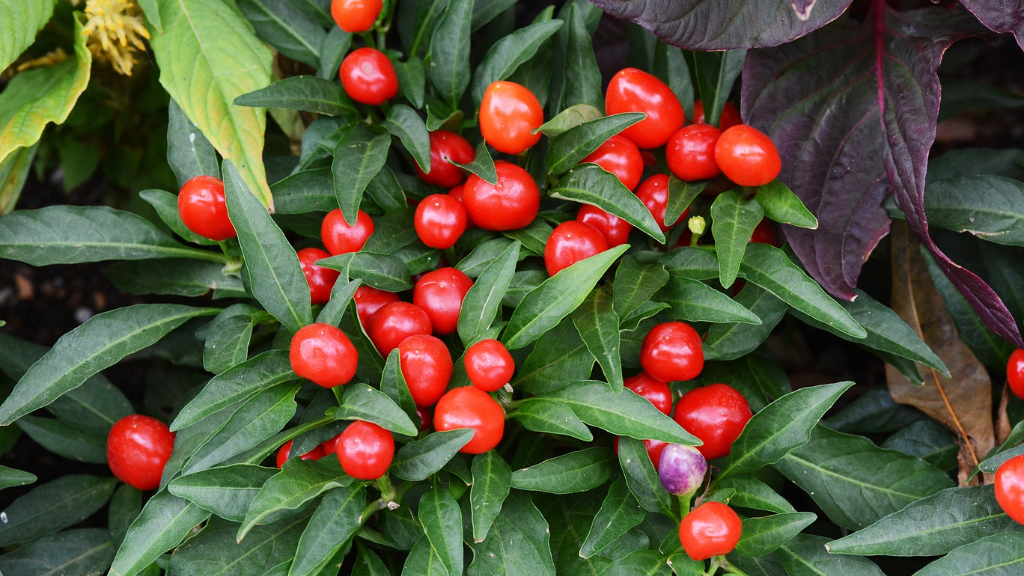Learn About Joe's Round Pepper Plants


There's nothing like adding a little pep in your step and hot peppers can do just that. Heirloom varieties are even better and packed with lots of intense flavor. An interesting type, whether you eat them or not, is the Joe's Round pepper.
History of Joe's Round Peppers
Peppers are believed to be native to tropical areas of the West Indies, Mexico, Central America and South America, where they were cultivated by ancient civilizations long before the appearance of European navigators. Explorers are responsible for distribution of the piquant chili peppers, which eventually found their way to countries around the world. Unfortunately, plant experts don't know too much about the specific history of Joe's Round peppers. Joe's Round peppers are also known as Ammazzo, an Italian word for 'nosegay' that means "small bunch of flowers."
The name couldn't be more appropriate for this heirloom variety which produces clusters of small, marble-like peppers. The little peppers, which ripen from dark green to red, are edible, and the flavor ranges from mild to medium-hot; however, most gardeners grow Joe's Round pepper plants for their ornamental value. In fact, this heirloom pepper is great for growing in containers.
Growing Joe's Round Peppers
Like all chili peppers, growing Joe's Round Peppers can be a bit tricky. The plants will thrive in bright sunlight and well-drained soil, especially if the soil is generously amended with manure or compost, along with a good, all-purpose fertilizer. You probably won't be able to find these heirloom pepper seeds in your local garden center, but they are available from growers that specialize in heirloom plants.
If you can't find them locally, search for Joe's Red peppers online. Start the seeds indoors in mid-spring and transplant the young plants into the garden when nighttime temperatures are consistently above 50 F. (10 C.). If you're concerned about chilly nights, protect the tender seedlings with hot caps.
Don't plant your chilies in the same garden spot if you have grown the plant's cousins - potatoes, eggplant or tomatoes - in the last three years. Harmful diseases may remain in the soil. Feed the seedlings a diluted mixture of water-soluble fertilizer, then repeat the application in about a month. Water the plants regularly and never let the soil become wet and soggy or bone dry; uneven watering can result in problems such as blossom end rot, sunscald or dropped blooms.
As a general rule, provide 1 to 2 inches of water per week. Water deeply to saturate the soil around the roots, then let the soil dry slightly before watering again. Watch for aphids, and if you notice the pests, spray them with an insecticidal soap spray, but don't apply soap spray when the sun is directly on the leaves or if temperatures are above 90 degrees F. or 32 C.
Gardening tips, videos, info and more delivered right to your inbox!
Sign up for the Gardening Know How newsletter today and receive a free copy of our e-book "How to Grow Delicious Tomatoes".
If you are growing Joe's Round peppers for eating, plants should be ready to harvest between 35 and 45 days, when the vegetables are plump and firm. You can pick the peppers at any stage of ripeness, but keep in mind that the little peppers will become much hotter as they turn deep red.

A Credentialed Garden Writer, Mary H. Dyer was with Gardening Know How in the very beginning, publishing articles as early as 2007.
-
 Moody Blooms For Spring: 8 Types Of Black Flowers To Add Drama To Spring Displays
Moody Blooms For Spring: 8 Types Of Black Flowers To Add Drama To Spring DisplaysFrom midnight burgundies to inky violets, several types of black flowers can enrich and embolden a spring display. Try these brooding bloomers for a moody garden
By Tonya Barnett
-
 My Homemade Orchid Fertilizer Always Brings More Blooms – Here's The Easy Recipe That Transforms Plants
My Homemade Orchid Fertilizer Always Brings More Blooms – Here's The Easy Recipe That Transforms PlantsScientist-turned-gardener Mary Ellen Ellis shares her tried-and-tested DIY orchid fertilizer recipe, plus more ingredients to try for healthy, happy plants.
By Mary Ellen Ellis